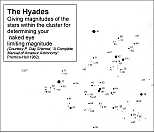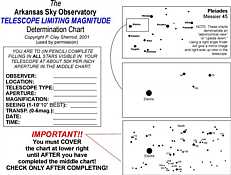TELESCOPE PERFORMANCE I - LIMITING MAGNITUDE CHARTS
Last updated: 5 February 2001
TELESCOPE PERFORMANCE I - LIMITING MAGNITUDE CHARTS |
From: sherrodc@ipa.net (Clay Sherrod)
The Arkansas Sky Observatory Telescope Limiting Magnitude Determination Chart
The Meade ETX telescopes are incredible instruments, both in electronic innovation and in their optical performance. I have published a field test on this web site in which the results of some stringent parameters were tested with my ETX 125 5" Maksutov. Many amateurs who have not had the opportunity to REALLY use an ETX may not understand that the optical design of these telescopes is pretty close to perfect and their performance reveals just that.
Lately, I have had a lot of correspondence from ETX users and other astronomers regarding "limiting magnitude" when using the telescope visually. Visual limiting magnitude MUST be differentiated from PHOTOGRAPHIC magnitude, in that the camera's film (and CCD imaging) has the ability to accumulate light, like a "sponge" slowly soaking up water.
In addition few amateur astronomers realize that there is a significant difference in their abilities to see certain COLOR stars, normally with very reddish stars appearing more difficult than blue or white ones to discern when very faint.
The telescope's (or the eye's) ability to "reach" a limiting magnitude (say, 11.8 with the ETX 90 or 12.8 with the ETX 125) is termed the visual "threshold," that point when the very faintest of stars.....sometimes can be seen....and sometimes can't! If you can, indeed, get even a momentary glimpse of that faint star you can honestly attest to the fact that the magnitude of THAT star is your limiting magnitude.
There is considerable discrepancy in the literature as to the limiting magnitude of ANY optical system, including the human eye. In a telescope it will be restricted by:
1) the type of telescope, i.e., refractor, reflector, catadioptic;
2) the type of glass the image must pass through (including eyepieces);
3) the transparency of the dark skies in which the scope is used;
4) the visual acuity of the observer; and,
5) the quality of the optics, including coatings.
There are formulae available in all the books that I will not bore you with; from that formulae, I have prepared a MEAN value, an average of sorts, of all of them and offer the list below. My 32 years in astronomy has shown me that this list is, indeed, VERY close to actual performance.
Under the darkest conditions (see below)
HUMAN EYE - 6.5 5.0" - 12.8
2.5" - 10.5 6.0" - 13.2
3.5" - 11.4 7.0" - 13.6
4.0" - 11.7 8.0" - 13.9
and so on....conditions vary, scopes vary and observers vary. And so will a limiting magnitude from scope to scope. BUT NOT BY MORE THAN 0.4 magnitude under the identical conditions at the same instant with two observers of equal visual acuity.
Now, that being said, let's find out what we can see.
First you must determine how visually acute YOU are. I noted above that on dark skies, you might be able to glimpse a star magnitude 6.5. That's pushing it under perfect conditions and age is most definitely a factor. The Native Americans of North America used the Pleiades as an eye test as well as Alcor and Mizar in Ursa Major; in the latter, if the "rider" could be seen atop the "horse," the young man was deemed suitable to become a warrior if all other tests (no drug tests back then) proved likewise. Many times skilled observers can see to magnitude 7.1 with the naked eye on high desert dry mountains and from peaks such as Mauna Kea in Hawaii, high above the earth's vapor layer.
We, too, can use the "asterisms" of the Hyades and Pleiades in the constellations of Taurus to determine our visual (eye) and telescope's limiting magnitude.
1) The first chart (on the left; click to get full size image for printing) is a star diagram of the Hyades. (from, "A Complete Manual of Amateur Astronomy," P. Clay Sherrod, 1982; permission by the author) giving the magnitudes of stars from bright Aldebaran to the very faintest. In addition to your eyes - try your BINOCULARS on this chart to determine their limiting magnitude as well.
With both charts, be sure to use a red flashlight to view or sketch on the chart to maintain your night vision; even when using the red light, you must wait about 2-3 minutes after illuminating the chart and then turning off the light to commence viewing to allow your eyes to adapt.
2) The second chart (on the right; click to get full size image for printing) is a challenge. This is a detailed three-part chart of the Pleiades star cluster, centering on the star ELECTRA. The first Pleiades chart shows the familiar pattern provided by the "8" stars of the "Seven Sisters." All of these should be visible to you on a dark night.


Like the naked eye test ONLY try this on the darkest of all nights and ONLY when the clusters are nearly DIRECTLY OVERHEAD!
The second Pleiades chart is your target: locate ELECTRA and center it at high power (about 50x per inch aperture); identify the three stars that comprise the triangle just EAST of Electra; they should be visible in your telescope. This pattern including and surrounding Electra will be in your field of view at 150x.
NOW, without looking at the lower right chart (the one that gives you what stars are really there and their magnitudes) sketch in with a pencil EVERY STAR you see through your telescope; take your time....take some breaks. It should take at least one hour, and it's worth it.
When you're done, compare what YOU have drawn with what I have provided. The numbers given (the largest being the faintest stars) are without decimal points; if you have indicated a star of "135" and no larger number, that is your limiting magnitude!
There is a distinct advantage in using the Pleiades in that nearly all stars are "O" and "B" type whitish and bluish stars and more visually attainable; also, it eliminates any error that could be introduced if you were, say, "red sensistive."
IMPORTANT NOTE!! These charts were developed by me in 1976 for an asteroid identification program using large professional telescopes. Those telescopes always photographed and displayed "astronomically correct" images, that is they were "upside down" but correct right and left. Unfortunately, nearly all telescopes today utilize right-angle attachments which give an upright, but mirror-image view. Consequently, you will be required to orient yourself to the star pattern surround Electra....it is VERY important that you identify the small triangle composed of the "7.9, 8.0 and 10.2" magnitude stars in RELATION to Electra. Another alternative would be to LOOK AT THIS CHART IN A MIRROR, AND TURN IT UPSIDE DOWN. That would provide the correct orientation. A third and best alternative would be to use a "visual back" that accepts eyepiece onto the rear cell of the telescope and view directly through the instrument, making your view exactly that of the charts.
If you have the terrestrial erect image prism for daytime viewing, you can use that and simply turn the chart upside down. However, this prism has optical elements that will REDUCE your limiting magnitude by as much as ONE-HALF magnitude!
Good luck, and report back here your results! If enough observers report back soon, I will extrapolate the curve for different telescopes and provide you with a sample. Not only is this project FUN, but it will educate you very well on the capabilities of your pride and joy - that neat little ETX or LX telescope!
P. Clay Sherrod
Arkansas Sky Observatory
Conway / Petit Jean Mountain
Arkansas
Return to the top of this page.
Go back to the Observational Guides & References page.
Go back to my ETX Home Page.